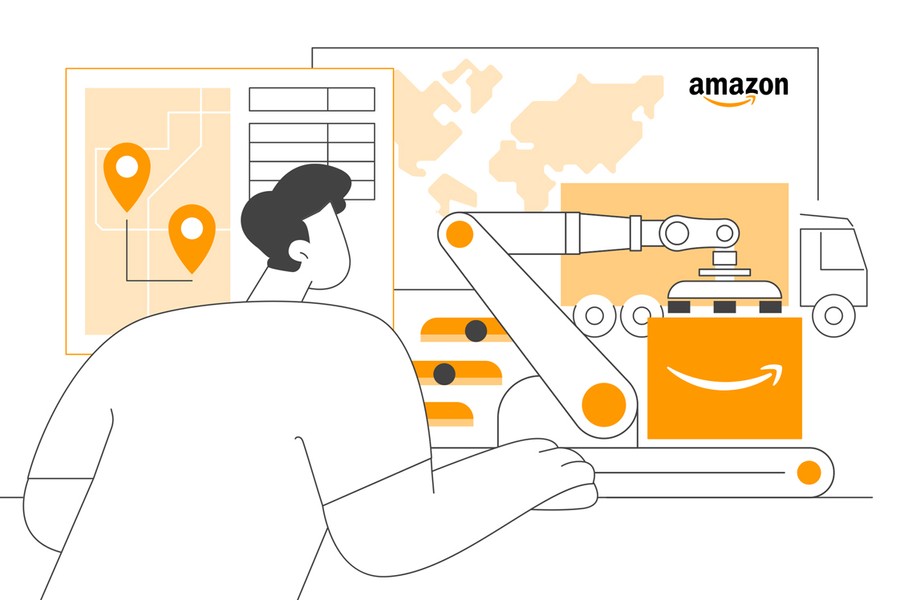Amazon needs no introduction. Whether through brown cardboard packages arriving on your doorstep, Amazon originals streamed into your living room, or cloud-based solutions built on Amazon Web Services (AWS), Amazon touches most of our lives daily.
We are not short of information on Amazon, with multiple books detailing its operations, yet there is often no substitute for seeing it with one’s own eyes and so, as part of our regular company meetings, your author visited the LCY3 Amazon Fulfilment Centre (FC) in Dartford. Entering the FC a sign greets fellow ‘Amazonians’ and reminds them ‘it’s still day one’: a reference to a saying used by Jeff Bezos to convey the continued culture of innovation that he tries to sustain at the ecommerce behemoth.
A product begins its journey through the FC once it has come in off a truck and been delivered onto a conveyor belt. The belt delivers the product to an Amazon worker where the ‘stocking’ stage begins. There is a mix of automation and human-driven processes within the five-story FC, however stocking still requires a human in the loop. The products are scanned into yellow boxes called ‘totes’. Whilst the process still requires a human touch, the categorising is automated and here the product is registered for the first time. The stocking process continues as the yellow tote is whisked away on a conveyer belt to one of the four floors above used solely for storing inventory. Each floor is the size of seven football pitches, a scale fairly hard to comprehend from inside.
It is hard to imagine anything but the most sophisticated competitors being able to challenge Amazon’s logistics prowess.
Up we walked to the second floor, watching the totes follow a 20-mile-long series of conveyer belts. The totes are delivered to an Amazon worker on the second floor where each product is loaded into a tall and thin yellow tower, under which a small orange robot sits, lifting and transporting the tower around the floor. The orange robots are made by Amazon Robotics LLC – formerly Kiva, a company Amazon acquired. To my untrained eye, they looked strangely similar to those robotic vacuum cleaners often found buzzing autonomously around suburban houses. These little orange warriors are the engine of the Amazon inventory system and can lift up to 770kg. The worker scans the product and then waits for the yellow tower to make its way over to them for filling. The correct space in the tower is lit up by a spotlight and another camera watches over to ensure this process is done correctly. The tower then departs and the stocking process is complete.
The next process starts once you click buy on Amazon’s website. The ‘picking’ process involves another Amazon worker standing at the other side of the inventory floor waiting for the arrival of the yellow tower containing your new toothbrush. There is no walking involved and instead, the product is brought to the worker to increase efficiency. The product is removed from the tower before it whizzes away to either another picker or is loaded up with another product in the stocking phase. Once the product is scanned it is placed in yet another yellow tote. Again, a spotlight and camera system makes sure no mistakes are made here either and on the conveyor belt system the tote goes.
Downstairs we go, following our package on its journey to the ‘packing’ stage. Another Amazon worker awaits the delivery of the tote. Out come the products one by one. First scanned, then packaged into the iconic Amazon cardboard boxes – complete with recycled brown paper to prevent damage. Before being boxed, the item is scanned by the worker, with the screen telling them which box or bag size to use. Amazon’s philosophy is all about incremental improvement and it’s easy to see how every process has been optimised. A barcode is attached and the product is placed back on a conveyer belt for a final time. The packaged product’s barcode is scanned and weighed as a final quality control before entering Amazon’s last-mile delivery network, ready to be delivered to your door.
It is easy enough to read about Amazon’s logistics prowess but seeing it in the flesh really does cement the complexity of the system they have created. As processes continue to be developed, it is hard to imagine anything but the most sophisticated competitors being able to challenge it. But this technology does not come cheap, and Amazon’s international e-commerce business is still barely profit-making. Competitive advantages abound, yet the question remains how profitable logistics at this scale can ever become.




